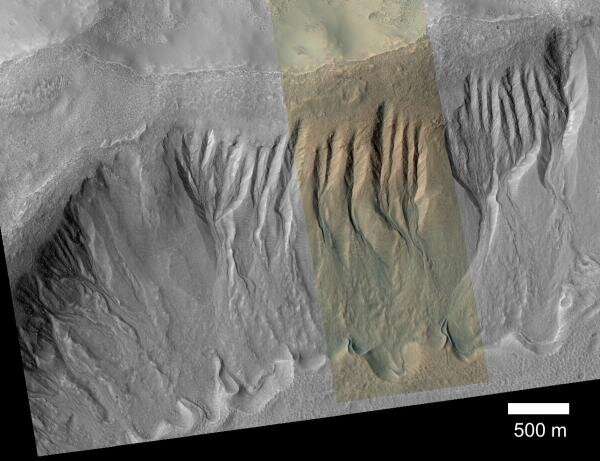This image of Mars from the High Resolution Imaging Science Experiment (HiRISE) camera aboard NASA’s Mars Reconnaissance Orbiter shows gullies that may have been carved by liquid water emerging from subsurface aquifers, a hypothesis for which Stephen Wood’s research provides support. Credit: NASA/JPL/University of Arizona
A new analytic model for calculating the effective thermal conductivity of planetary regolith allows scientists to better understand the connections between the physical and thermal properties of planetary surfaces and the processes that depend on them, according to Planetary Science Institute Senior Scientist Stephen E. Wood, author of "A Mechanistic Model for the Thermal Conductivity of Planetary Regolith 1: The Effects of Particle Shape, Composition, Cohesion and Compression at Depth," which appears in Icarus.
"Thermal conductivity largely controls the range of temperatures experienced at the surface and in the subsurface. This is important because surface and subsurface temperatures affect many planetary processes such as controlling the stability of ice, the behavior and dynamics of the atmosphere, and even the thickness of the lithosphere, the rigid outer shell of planetary bodies," Wood said.
Wood's model predictions of subsurface thermal conductivity imply that temperatures may increase with depth more rapidly than previously assumed. For the case of Mars, temperatures may allow for liquid water just a few hundred meters below the surface, making this a potential target for finding life on Mars today. For the case of asteroids, pressure from thermal radiation that depends upon surface temperature and thermal conductivity can perturb an asteroid's orbit enough to transport it from the asteroid belt to the inner solar system, increasing its potential for impacting the Earth.
"The thermal conductivity of regolith on Mars is very sensitive to particle size, so this model also makes it possible to effectively measure regolith particle sizes from orbit. This has implications for aeolian (wind) transport processes that form dunes or dust storms as well as physical weathering processes," Wood said.
"This paper provides planetary scientists with a theoretically robust and easy to use tool for calculating the thermal conductivity of planetary regolith," Wood said. "The paper also provides experimentalists with a more complete list of parameters that should be measured and reported, such as particle shape and precise composition, to enable better comparison of model predictions with laboratory measurements."
More information: Stephen E. Wood. A mechanistic model for the thermal conductivity of planetary regolith: 1. The effects of particle shape, composition, cohesion, and compression at depth, Icarus (2020). DOI: 10.1016/j.icarus.2020.113964
Journal information: Icarus
Provided by Planetary Science Institute























